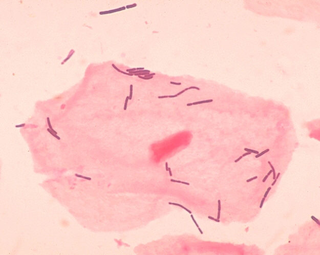Related Research Articles

Lactobacillus is a genus of Gram-positive, aerotolerant anaerobes or microaerophilic, rod-shaped, non-spore-forming bacteria. Until March 2020, the genus Lactobacillus comprised over 260 phylogenetically, ecologically, and metabolically diverse species; a taxonomic revision of the genus in 2020 assigned lactobacilli to 25 genera including the homofermentative genera Lactobacillus, Holzapfelia, Amylolactobacillus, Bombilactobacillus, Companilactobacillus, Lapidilactobacillus, Agrilactobacillus, Schleiferilactobacillus, Loigolactobacillus, Lacticaseibacillus, Latilactobacillus, Dellaglioa, Liquorilactobacillus, Ligilactobacillus and Lactiplantibacillus and the heterofermentative genera Furfurilactobacillus, Paucilactobacillus, Limosilactobacillus, Fructilactobacillus, Acetilactobacillus, Apilactobacillus, Levilactobacillus, Secundilactobacillus and Lentilactobacillus. Properties of the genera are indicated below; two websites inform on the assignment of species to the novel genera.

The Rhizobiales are an order of Gram-negative Alphaproteobacteria.
The Aurantimonadaceae are a small family of marine bacteria. Six species are known. Aurantimonas coralicida causes a white plague in corals. Fulvimarina pelagi was isolated from seawater, and takes the form of nonmotile rods.

The Burkholderiaceae are a family of bacteria included in the order Burkholderiales. It includes some pathogenic species, such as Burkholderia mallei (glanders) and Burkholderia pseudomallei (melioidosis).

Halomonadaceae is a family of halophilic Proteobacteria.
Pediococcus is a genus of gram-positive lactic acid bacteria, placed within the family of Lactobacillaceae. They usually occur in pairs or tetrads, and divide along two planes of symmetry, as do the other lactic acid cocci genera Aerococcus and Tetragenococcus. They are purely homofermentative. Pediococcus dextrinicus has recently been reassigned to the genus Lactobacillus.
Lacticaseibacillus rhamnosus is a bacterium that originally was considered to be a subspecies of L. casei, but genetic research found it to be a separate species in the L. casei clade, which also includes L. paracasei and L. zeae. It is a short Gram-positive homofermentative facultative anaerobic non-spore-forming rod that often appears in chains. Some strains of L. rhamnosus bacteria are being used as probiotics, and are particularly useful in treating infections of the female urogenital tract, most particularly very difficult to treat cases of bacterial vaginosis. The species Lacticaseibacillus rhamnosus and Limosilactobacillus reuteri are commonly found in the healthy female genito-urinary tract and are helpful to regain control of dysbiotic bacterial overgrowth during an active infection. L. rhamnosus sometimes is used in dairy products such as fermented milk and as non-starter-lactic acid bacterium (NSLAB) in long-ripened cheese. While frequently considered a beneficial organism, L. rhamnosus may not be as beneficial to certain subsets of the population; in rare circumstances, especially those primarily involving weakened immune system or infants, it may cause endocarditis. Despite the rare infections caused by L. rhamnosus, the species is included in the list of bacterial species with qualified presumed safety (QPS) status of the European Food Safety Agency.
The indole test is a biochemical test performed on bacterial species to determine the ability of the organism to convert tryptophan into indole. This division is performed by a chain of a number of different intracellular enzymes, a system generally referred to as "tryptophanase."
Cronobacter is a genus of Gram-negative, facultatively anaerobic, oxidase-negative, catalase-positive, rod-shaped bacteria of the family Enterobacteriaceae. They are generally motile, reduce nitrate, use citrate, hydrolyze esculin and arginine, and are positive for L-ornithine decarboxylation. Acid is produced from D-glucose, D-sucrose, D-raffinose, D-melibiose, D-cellobiose, D-mannitol, D-mannose, L-rhamnose, L-arabinose, D-trehalose, galacturonate and D-maltose. Cronobacter spp. are also generally positive for acetoin production and negative for the methyl red test, indicating 2,3-butanediol rather than mixed acid fermentation. The type species of the genus Cronobacter is Cronobacter sakazakii comb. nov.
Staphylococcus vitulinus is a Gram-positive, coagulase-negative member of the bacterial genus Staphylococcus consisting of clustered cocci. The species was originally isolated from food and animals and was named Staphylococcus vitulus. The name was later changed to Staphylococcus vitulinus for correct Latin grammar.

Lactobacillus delbrueckii is a species of bacteria in the family Lactobacillaceae. It is part of the microbiota of the lower reproductive tract of women.
Prosthecomicrobium is a genus of aerobic bacteria which was isolated from freshwater samples.
Kandleria is a genus from the family of Erysipelotrichidae, with one known species.
Avibacterium is a Gram-negative genus from the family of Pasteurellaceae.
Thalassotalea is an aerobic and chemo-organo-heterotrophic genus of bacteria from the family Colwelliaceae which occur in the ocean and in sea ice.
Noviherbaspirillum aurantiacum is a Gram-negative and motile bacterium from the genus of Noviherbaspirillum which has been isolated from old volcanic mountain soil.
Olsenella profusa is a bacterium from the genus of Olsenella which has been isolated from subgingival plaque in the United States.
Giesbergeria is a genus of bacteria from the family of Comamonadaceae. Giesbergeria is named after the Dutch microbiologist G. Giesberger.
Giesbergeria voronezhensis is a Gram-negative, spiral-shaped and motile bacterium from the genus of Giesbergeria which has been isolated from activated sludge from Voronezh in Russia.
Pseudooceanicola batsensis is a Gram-negative, rod-shaped, chemoheterotrophic and non-motile bacterium from the genus of Pseudooceanicola which has been isolated from seawater from the Sargasso Sea.
References
- 1 2 Parte, A.C. "Kandleria". LPSN .
- 1 2 "Kandleria vitulina". www.uniprot.org.
- 1 2 "Details: DSM-20405". www.dsmz.de.
- 1 2 Salvetti, E.; Felis, G. E.; Dellaglio, F.; Castioni, A.; Torriani, S.; Lawson, P. A. (26 November 2010). "Reclassification of Lactobacillus catenaformis (Eggerth 1935) Moore and Holdeman 1970 and Lactobacillus vitulinus Sharpe et al. 1973 as Eggerthia catenaformis gen. nov., comb. nov. and Kandleria vitulina gen. nov., comb. nov., respectively". International Journal of Systematic and Evolutionary Microbiology. 61 (10): 2520–2524. doi: 10.1099/ijs.0.029231-0 . PMID 21112984.